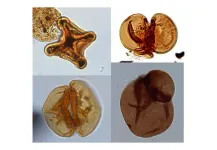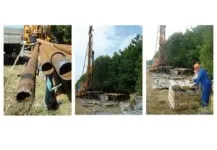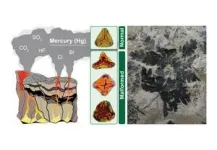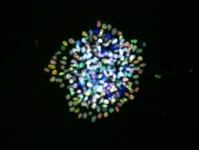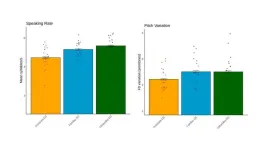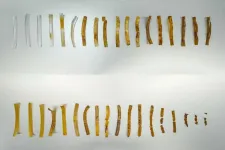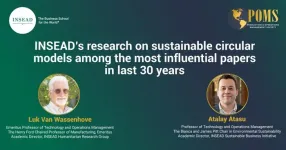(Press-News.org) The link between massive flood basalt volcanism and the end-Triassic (201 million years ago) mass-extinction is commonly accepted. However, exactly how volcanism led to the collapse of ecosystems and the extinction of entire families of organisms is difficult to establish. Extreme climate change from the release of carbon dioxide, degradation of the ozone layer due to the injection of damaging chemicals, and the emissions of toxic pollutants, are all seen as contributing factors. One toxic element stands out: mercury. As one of the most toxic elements on Earth, Hg is a metal that is emitted from volcanoes in gaseous form, and thus has the capacity to spread worldwide. A new study in Nature Communications adds new compelling evidence for the combined effects of global warming and widespread mercury pollution that continued to stress plants long after volcanic activity had ceased.
An international team of Dutch, Chinese, Danish, British, and Czech scientists studied sediments from Northern-Germany in a drill-core (Schandelah-1) that spans the uppermost Triassic to lower Jurassic for microfossils and geochemical signals. A study of pollen and spore abundances revealed a profusion of fern spores showing a range of malformations, from abnormalities in wall structure to evidence for botched meiotic divisions, leading to unseparated, dwarfed, and fused fern spores. “Seeing the sheer amount and different types of malformed fern spores in sediment samples from a coastal lagoon, dating back 201 million years ago is truly astonishing. It means there must have been very many ferns being stressed,” explains Remco Bos, a PhD candidate at Utrecht University and lead author of the study. “It is also not something we see regularly during other periods that also contain many fern fossils, making it a true signal connected to the end-Triassic mass-extinction event.”
Deforestation and ferns
The results from Bos and co-authors confirm earlier work by co-authors Sofie Lindström (University of Copenhagen), Hamed Sanei (Aarhus University), and Bas van de Schootbrugge (Utrecht University), who previously produced similar data obtained from cores from Denmark and from nearby outcrops in Sweden. According to Sofie Lindström: “Ferns replaced trees across the extinction interval in response to dramatic environmental changes likely driven by heat stress, strongly increased monsoonal rainfall, and increased forest fire activity. Palynological results show that a pioneering fern vegetation spread across vast swaths of coastal lowlands in Northwestern Europe from Sweden and Denmark to Germany, France, Luxemburg, and Austria in response to widespread deforestation”. Ferns are hardy plants, often colonizing disturbed environments, including newly formed volcanic islands or landscapes devastated by volcanism or wildfires. “What is extraordinary here is that the ferns that produced all these malformed spores in all these different sites, did not go extinct. While other plants went extinct, ferns were apparently robust enough to continue, which could also be related to their different mercury tolerance.”
Climate variability
In this new study, Bos and co-authors show that the ferns, which took advantage of the dieback of forests, themselves were subjected to stress from Hg-pollution well beyond the immediate extinction interval. “We found four more intervals with high levels of Hg concentrations and high numbers of malformed spores in the 1.3 to 2 million years following the extinction interval,” explains Remco Bos. This interval, known as the Hettangian, was a time of continuing adverse conditions in the oceans, with generally low diversities among marine invertebrates, such as ammonites and bivalves. On land, however, vegetation appeared to have recovered quicker. “We now show that this forest ecosystem continued to be perturbed repeatedly for at least 1.3 million years, but perhaps as long as 2 million years,” Bos explains.
The four additional episodes of high Hg concentrations and high fern spore malformations were unlikely connected to later phases of Central Atlantic Magmatic Province volcanism. Instead, Bos and co-authors show that these periods correspond closely to the long eccentricity cycle, the major variation in the shape of Earth’s orbit that moves Earth closer or further away from the Sun every 405 thousand years. During eccentricity maxima Earth moves closer to the Sun allowing for more sunlight to reach the Earth surface. As the Earth’s atmosphere was already supercharged with carbon dioxide from the large-scale volcanism, this cyclic modulation of the climate system repeatedly triggered forest dieback, allowing for the renewed spread of pioneer ferns. As is shown by the correlation with high Hg contents, malformations in fern spores during these episodes were also the result of mercury poisoning. But where did this Hg come from?
Hg-isotopes
A crucial data set was generated at Tianjin University (China) by Wang Zheng, a co-corresponding author and geochemist specialized in metal isotope studies, especially Hg-isotopes. Mercury has different stable isotopes that behave differently in the environment. During reactions in nature, for example the expulsion from volcanism, deposition from the atmosphere, and the uptake by organisms, Hg-isotopes can become fractionated, enriching one pool in heavier isotopes, and others in lighter isotopes. Sediments with elevated levels of Hg and malformed spores also show clear variations in Hg-isotopes. “Based on the Hg-isotope variations we were able to link an initial pulse in Hg enrichment at the Triassic-Jurassic boundary to the emission of mercury from flood basalt volcanism,” Wang Zheng explains. “However, the four other pulses in mercury had a different isotopic composition, indicating they were mainly driven by Hg input from soil erosion and photochemical reduction.”
Climate change and toxic pollution
The combined geochemical and microfossil data thus paint a picture of a much more complex and drawn-out sequence of events, starting with massive volcanism driving climate change and releasing toxic pollutants, followed by episodic pulses of disturbance in the aftermath of the extinction event lasting for at least 1.3 million years. Dr. Tomas Navratil from the Czech Academy of Sciences, a co-author on the paper and a specialist for modern-day mercury pollution, agrees with this scenario. “Our work on polluted sites in the Czech Republic does show evidence for episodic remobilization from forest soils, especially during hot summers, and in places that are more exposed to sunlight causing the photochemical reduction of mercury and re-release to the atmosphere of previously stored mercury”.
“We know that mass-extinction events were complex and long-lasting events. Here we show that a mix of greenhouse warming and pollution led to continued ecosystem perturbation. Coastal ecosystems likely suffered the most by receiving large amounts of mobilized mercury from vast catchment areas. Eventually, the system recovered during the Sinemurian, when we see stable forested biomes appear. It is likely that by that time, Earth had cleaned up the mess, carbon dioxide levels went down, and mercury was buried for good in offshore marine sediments,” Bos concludes.
END
Climate change and mercury pollution stressed plants for millions of years
Volcanic province drove mass-extinction and disturbance afterwards
2024-04-30
ELSE PRESS RELEASES FROM THIS DATE:
Stowers Institute for Medical Research appoints new Assistant Investigator
2024-04-30
KANSAS CITY, MO—April 30, 2024—The Stowers Institute for Medical Research announces the appointment of Kamena Kostova, Ph.D., as its newest Principal Investigator. Kostova, an accomplished cellular and molecular biologist, will join the Institute in Fall 2024 as an Assistant Investigator. She brings with her an established research program focused on understanding cellular responses to ribosome breakdown and the relationship these responses have with complex diseases such as cancer and neurodegeneration.
Kostova is currently ...
Science council: “Tasks excellently fulfilled”
2024-04-30
The German Science and Humanities Council (Science Council) assessed the German Fed-eral Institute for Risk Assessment (BfR) in Berlin on 7 and 8 November 2023 and published its assessment today, 22 April 2024. As the highest German scientific commission, it certi-fies that the BfR “fulfills tasks of great social relevance” (protection of human health, in-forming the public about health risks posed by chemicals and biological substances) “on the basis of very good research”. It is characterised by an “extremely rapid response capability, a pronounced application orientation and a high degree of being up-to-date with its topics”. “We are delighted ...
USC-led study introduces a new and improved way to grow the cells that give rise to the kidney’s filtration system
2024-04-30
In a new study published in Cell Stem Cell, USC scientists report significant progress in cultivating nephron progenitor cells (NPCs), the cells destined to form the kidney’s filtration system, the nephrons. NPCs hold immense promise for understanding kidney development, modeling diseases, and discovering new treatments.
“By enhancing our capability to grow NPCs from human stem cells, we create a new avenue for understanding and combating congenital kidney diseases and cancer,” said corresponding and lead author Zhongwei Li, an assistant professor of medicine, and stem cell biology and regenerative medicine ...
USPSTF recommendation statement on screening for breast cancer
2024-04-30
Bottom Line: The U.S. Preventive Services Task Force (USPSTF) recommends biennial screening mammography for women ages 40 to 74. The USPSTF concludes that the current evidence is insufficient to assess the balance of benefits and harms of screening mammography in women 75 years or older. The USPSTF concludes that the current evidence is insufficient to assess the balance of benefits and harms of supplemental screening for breast cancer using breast ultrasonography or magnetic resonance imaging (MRI) in women identified to have dense breasts on an otherwise negative screening mammogram. Among ...
Machine listening: Making speech recognition systems more inclusive
2024-04-30
WASHINGTON, April 30, 2024 – Interactions with voice technology, such as Amazon’s Alexa, Apple’s Siri, and Google Assistant, can make life easier by increasing efficiency and productivity. However, errors in generating and understanding speech during interactions are common. When using these devices, speakers often style-shift their speech from their normal patterns into a louder and slower register, called technology-directed speech.
Research on technology-directed speech typically focuses on mainstream varieties of U.S. English without considering speaker groups that are more consistently ...
Biodegradable ‘living plastic’ houses bacterial spores that help it break down
2024-04-30
A new type of bioplastic could help reduce the plastic industry’s environmental footprint. Researchers led by the University of California San Diego have developed a biodegradable form of thermoplastic polyurethane (TPU), a soft yet durable commercial plastic used in footwear, floor mats, cushions and memory foam. It is filled with bacterial spores that, when exposed to nutrients present in compost, germinate and break down the material at the end of its life cycle.
The work is detailed in a paper published on April 30 in Nature Communications.
The biodegradable TPU was made with ...
Loneliness grows as we age
2024-04-30
Adults are lonelier in early and older adulthood, less lonely in middle adulthood
Consistent loneliness pattern found across nine longitudinal studies, all collected prior to COVID-19 pandemic
CHICAGO --- Loneliness in adulthood follows a U-shaped pattern: it’s higher in younger and older adulthood, and lowest during middle adulthood, reports a new Northwestern Medicine study that examined nine longitudinal studies from around the world.
The study also identified several risk factors for heightened loneliness across the whole lifespan, including ...
Listening to mindfulness audios during radiation improves physical, emotional side effects
2024-04-30
It’s a ‘twofer’: Helping men manage side effects, receive cancer treatment at same time
Men with cancer rarely participate in oncology supportive care: ‘You build it, and they don’t come’
First study to deliver mindfulness during radiation therapy while patients were ‘a captive audience’
CHICAGO --- Men with prostate cancer who are treated with radiation therapy experience significant side effects such as fatigue, sleep problems, anxiety and depressive symptoms. But listening to mindfulness audio recordings significantly eased those symptoms, a new Northwestern ...
INSEAD’s research on sustainable circular models among the most influential papers in last 30 years
2024-04-30
Studies by INSEAD Professors Atalay Atasu and Luk Van Wassenhove have been recognised by members of the Product Operations Management Society for their impact.
Their papers are named among the top 10 most influential papers published in the first 30 years of the Production and Operations Management (POM) journal. They were voted for by POM society members based on an original list of 150 of the most cited papers since the publications launch in 1992.
Emeritus Professor Van Wassenhove is a co-author of two papers that made the top 10. His 2005 paper, “Sustainable Operations Management” looked at ...
Quitting smoking during pregnancy may have a positive effect on placental weight
2024-04-30
The researchers in Bergen and Exeter used data from the Norwegian Mother, Father and Child Cohort Study (MoBa) and a similar study in the UK, the Avon Longitudinal Study of Parents and Children (ALSPAC), to investigate the relationship between smoking and placental weight. The aim was to determine to what extent expectant mothers who quit smoking could impact the weight of the placenta at the time of birth.
The study was recently published in the journal BMC Pregnancy and Childbirth.
Previous research has demonstrated ...
LAST 30 PRESS RELEASES:
Numbers in our sights affect how we perceive space
SIMJ announces global collaborative book project in commemoration of its 75th anniversary
Air pollution exposure and birth weight
Obstructive sleep apnea risk and mental health conditions among older adults
How talking slows eye movements behind the wheel
The Ceramic Society of Japan’s Oxoate Ceramics Research Association launches new international book project
Heart-brain connection: international study reveals the role of the vagus nerve in keeping the heart young
Researchers identify Rb1 as a predictive biomarker for a new therapeutic strategy in some breast cancers
Survey reveals ethical gaps slowing AI adoption in pediatric surgery
Stimulant ADHD medications work differently than thought
AI overestimates how smart people are, according to HSE economists
HSE researchers create genome-wide map of quadruplexes
Scientists boost cell "powerhouses" to burn more calories
Automatic label checking: The missing step in making reliable medical AI
Low daily alcohol intake linked to 50% heightened mouth cancer risk in India
American Meteorological Society announces Rick Spinrad as 2026 President-Elect
Biomass-based carbon capture spotlighted in newly released global climate webinar recording
Illuminating invisible nano pollutants: advanced bioimaging tracks the full journey of emerging nanoscale contaminants in living systems
How does age affect recovery from spinal cord injury?
Novel AI tool offers prognosis for patients with head and neck cancer
Fathers’ microplastic exposure tied to their children’s metabolic problems
Research validates laboratory model for studying high-grade serous ovarian cancer
SIR 2026 delivers transformative breakthroughs in minimally invasive medicine to improve patient care
Stem Cell Reports most downloaded papers of 2025 highlight the breadth and impact of stem cell research
Oxford-led study estimates NHS spends around 3% of its primary and secondary care budget on the health impacts of heat and cold in England
A researcher’s long quest leads to a smart composite breakthrough
Urban wild bees act as “microbial sensors” of city health.
New study finds where you live affects recovery after a hip fracture
Forecasting the impact of fully automated vehicle adoption on US road traffic injuries
Alcohol-related hospitalizations from 2016 to 2022
[Press-News.org] Climate change and mercury pollution stressed plants for millions of yearsVolcanic province drove mass-extinction and disturbance afterwards
